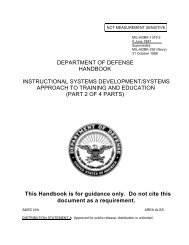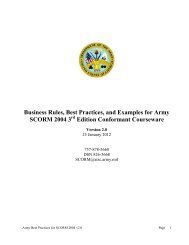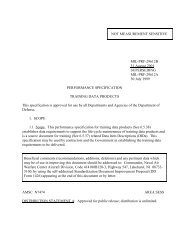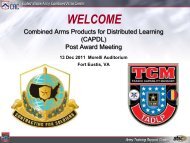dlxxi contract - U. S. Army Training Support Center
dlxxi contract - U. S. Army Training Support Center
dlxxi contract - U. S. Army Training Support Center
Create successful ePaper yourself
Turn your PDF publications into a flip-book with our unique Google optimized e-Paper software.
sequence, and content of training delivery using more than one type medium to convey<br />
the content of instruction. IMI can link a combination of media, to include programmed<br />
instruction, video tapes, slides, film, television, text, graphics, digital audio, animation,<br />
and up to full motion video, to enhance the learning process. Interactive multimedia<br />
instruction may be delivered on a stand-alone computer workstation, networked<br />
computers, or via the Internet. The interservice term “IMI” is synonymous with<br />
“computer based instruction (CBI)” and “computer based training (CBT).” For TRADOC,<br />
IMI is a group of computer-based training and training support products. IMI includes<br />
source materials that are commonly used in IMI products, electronic products used in the<br />
delivery of or supporting the delivery of instruction, and software management tools used<br />
to support instructional programs. Types of IMI include:<br />
C.10.13.1 Computer assisted instruction (CAI). CAI involves use of computers to aid in<br />
the delivery of instruction. CAI exploits computer technology to provide the storage and<br />
retrieval of information for both the instructor and student. CAI usually refers to the use of<br />
computers to support instructor-led classroom instruction. Using computers as a<br />
presentation tool media for slides, audio, or motion pictures which support large or small<br />
group instruction is an example of CAI.<br />
C.10.13.2 Computer-based instruction (CBI). CBI usually refer to course materials<br />
presented or controlled by a computer and which use multiple requirements for student<br />
responses as a primary means of facilitating learning.<br />
C.10.13.3 Computer-based <strong>Training</strong> (CBT). CBT usually refers to course materials<br />
presented or controlled by a computer and which use multiple requirements for student<br />
responses as a primary means of facilitating mastering a skill or task.<br />
C.10.13.4 Interactive Video Disk (IVD). IVD is an information storage and retrieval<br />
technology used with computers to support programs requiring a very large quantity of<br />
memory (e.g. long full motion video sequences or a very large library of complex<br />
graphics). IVD uses text, graphics, full motion video, and audio. It is always used on a<br />
videodisk-based system.<br />
C.10.14 Interactive Multimedia Instruction (IMI) Program. An assembly or series of<br />
closely related IMI lessons and concomitant instructional materials and documentation<br />
that are grouped together under a single identification number. An IMI program<br />
comprises one or more lessons (i.e., segments of instruction designed to teach one or<br />
more instructional objectives) that may be grouped into separate modules that can be<br />
taught, measured, and evaluated as a single unit.<br />
C.10.15 Internet/intranet/extranet. A worldwide communications network originally<br />
developed by the U.S. Department of Defense as a distributed system with no single point<br />
of failure. The Internet/intranet/extranet has seen an explosion in commercial use since<br />
the development of easy-to-use software for accessing the Internet/intranet/extranet.<br />
C.10.16 Interoperability. The capability to run courseware and associated programs<br />
without modification on a delivery system other than the one for which it was originally<br />
designed.<br />
C.10.17 Instruction. The process of systematically providing knowledge. For purposes<br />
of this document, instruction includes both training (i.e., the process of systematically

















